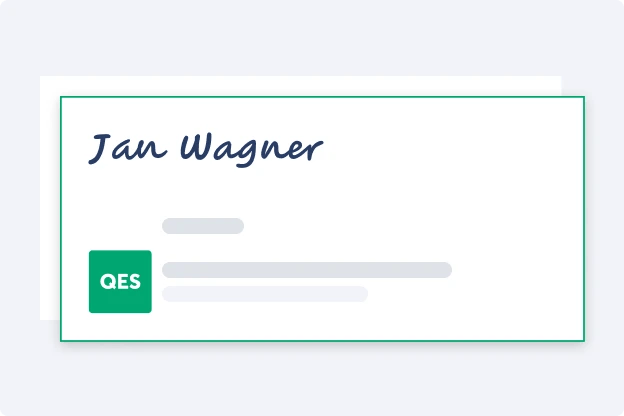An advanced electronic signature (AES) binds a verified signer to a file using cryptography and an auditable trail, giving tamper-evident proof of who signed and what was approved. This guide shows how to create, verify, and archive AES so you can decide if it is enough for your use case.
Advanced electronic signature: key takeaways
- An advanced electronic signature cryptographically binds a verified signer to one document, detects any change, and includes an audit trail.
- Use AES for medium-risk documents without a legal written-form requirement; define policy thresholds for higher-risk or regulated cases.
- A valid AES requires strong identity checks, a cryptographic seal with a trusted timestamp, a complete audit trail, and long-term validation.
- Skribble offers AES with EU/Swiss hosting so you can start fast and scale securely.
What is an advanced electronic signature?
An advanced electronic signature is a cryptographic e-signature that uniquely links a verified signer to a file and makes subsequent changes detectable. The term originates in Europe, while in the US (ESIGN/UETA) there are no formal levels, and the same stricter identity and integrity controls are recognized.
The eIDAS criteria for an advanced electronic signature:
- Uniquely linked to the signer
- Identifies the signer
- Created with data under the signer’s sole control
- Detects any post-signature change
Extended vs. qualified electronic signature: When to use which type?
Choose AES for medium-risk transactions without a statutory written-form requirement. Choose qualified electronic signature (QES) whenever written form is mandated or liability and fraud risk are high.
AES vs. QES: integrity, audit trail, long-term validation (LTV)
- AES: Cryptographic sealing of the document, timestamped audit trail, revocation-aware validation for LTV.
- QES: Everything in AES plus a qualified certificate and a qualified timestamp issued by a qualified trust service provider.
Where does AES sit within the types of electronic signatures?
- Simple electronic signature (SES): Basic identity checks and platform logs for low-risk approvals.
- AES: Stronger identity binding plus cryptographic integrity; suitable for medium risk.
- Qualified electronic signature (QES): Qualified identity verification and a qualified certificate issued to a natural person; legally equivalent to a handwritten signature where written form is required.
How to decide between AES and QES?
- Legal form: If the contract requires “written form,” use QES.
- Transaction value/exposure: Escalation to QES in the event of increasing financial or legal risk.
- Counterparty certainty: Use AES for known, low-risk counterparties; choose QES for unknown or high-risk parties.
- Regulatory domain: Industry regulations (e.g., employment, finance, health) may require QES.
- Internal policy: Thresholds and data classes may require AES or QES depending on the document type.
How do AES and QES differ in document integrity, audit trail, and LTV?
- AES: Cryptographic sealing of the document, timestamped audit trail, revocation-aware validation for LTV.
- QES: All AES controls plus a qualified certificate and qualified timestamp from a qualified trust service provider.
What security controls make an advanced electronic signature reliable?
An advanced electronic signature under eIDAS is only as strong as its identity checks, integrity controls, and evidence. Use a well-defined security plan to meet legal and audit requirements.
How should identity be verified for AES?
- Multi-factor authentication (MFA): One-time password (OTP) as well as verified email or phone.
- Electronic ID (eID) and electronic identity verification (eIDV): Strong binding to the natural person where available.
- Signer-held secret or key: Smart card, app token, or certificate under the signer’s sole control.
- Contextual signals: Knowledge-based authentication (KBA) only as an addition, never the sole factor.
How is document integrity ensured?
- Cryptographic sealing: Hash the file and apply Cryptographic Message Syntax (CMS) or PDF Advanced Electronic Signatures (PAdES) so that any changes are detectable.
- Trusted timestamps: Apply a verifiable timestamp when signing; for AES, these do not need to be qualified, but they must be verifiable.
- Field controls: Lock fields, roles, and workflows to prevent undetected changes.
What must the audit trail for AES contain?
- Events: Viewed, consented, signed, completed, with precise timestamps.
- Signers: Identifiers, roles, and the authentication steps used.
- Technical data: IP address and device information where lawful and proportionate.
- Document hash: Links the trail to one immutable file.
How can AES be kept verifiable on a long-term basis?
- Revocation data: Embed Online Certificate Status Protocol (OCSP) responses or Certificate Revocation Lists (CRLs) for signatures (PAdES-LTV).
- Timestamp renewal: Add periodic trusted timestamps per policy.
- Archive format: Prefer PDF for Archiving (PDF/A) and keep the trail together with the signed file.
- Scheduled re-verification: Log and store verification results.
AES security mini-checklist
- Identity: MFA (one-time code), eID/eIDV, signer-held key
- Integrity: CMS/PAdES seal, trusted timestamp, locked fields
- Evidence: Full audit trail + document hash (IP/device where lawful)
- LTV & governance: OCSP/CRL, PDF/A, periodic re-verification, EU/CH hosting, Single Sign-On (SSO) and Data Processing Agreement (DPA)
Start a free trial with Skribble to create advanced electronic signatures in seconds.
How do you use an advanced electronic signature?
To issue an AES, use strong identity checks, apply a cryptographic seal with a trusted timestamp, and keep a verifiable evidence report together with the signed file.
How to create an AES for PDF, Word, and mobile devices?
- Prepare the document: Finalize content; export Word to PDF to lock layout
- Select level: Choose AES in your workflow
- Set identity: Require MFA (one-time code + verified email/phone) or eID/eIDV; add signer roles and order
- Place fields: Signature, date, initials, required text; keep mobile labels short
- Send and sign: Signers review, authenticate, and sign in a browser on desktop, iOS, or Android
- Seal and timestamp: The platform applies a cryptographic seal and a verifiable timestamp
How to verify an advanced electronic signature?
- Seal and hash: Validate that the cryptographic seal and document hash match and that no post-signature edits are detected
- Evidence report: Check the event timeline for view, consent, sign, and complete with precise timestamps
- Identity steps: Confirm MFA or eID/eIDV details and signer identifiers and roles
How to archive an advanced electronic signature with LTV?
- Store together: Keep the signed PDF and the evidence report together, ideally as PDF for Archiving (PDF/A)
- Embed and renew: Embed Online Certificate Status Protocol (OCSP) or Certificate Revocation List (CRL) data and renew trusted timestamps per policy.
- Govern retention: Apply access controls, retention and deletion rules, and schedule periodic re-verification with stored results.
Which advanced electronic signature examples fit common workflows?
- HR: Contract amendments and benefits changes that need verified identity and tamper evidence.
- Sales & Procurement: Mid-value SOWs, renewals, and partner onboarding requiring a full audit trail.
- Legal & Operations: NDAs with external parties and service/maintenance approvals with integrity checks.
Identity & assurance
- MFA with one-time password plus verified email/phone
- eID or eIDV; optional bank ID
- Signer-held keys or certificates (smart card or app token)
- Policy-based configuration per document risk
Integrity & evidence
- Cryptographic sealing (CMS/PAdES) and a trusted timestamp when signing
- Full audit trail: events, roles, authentication steps, document hash
- Long-term validation (LTV) with OCSP/CRL data embedded
Admin & governance
- Role-based access, approval routing, and template locking
- Retention/deletion policies, legal holds, exportable evidence
- Accessibility and localization for DACH teams
Integrations & developer
- Native connectors for CRM/HRIS/ERP and cloud storage
- REST API/SDKs, webhooks for status sync, branding in templates/emails
- SSO and SCIM for user lifecycle
Data protection & residency
- EU or Swiss hosting with a signed DPA
- Transparent subprocessors, encryption in transit/at rest
- Documented incident SLAs and audit support
Put AES into practice with Skribble
Skribble lets you run AES across HR, sales, and legal with EU or Swiss hosting, MFA, cryptographic sealing, and a complete evidence report:
- Hire and onboard faster
- Close deals and approve purchases sooner
- Pass audits with less effort
- Meet EU privacy expectations
- Keep costs predictable as you scale
If a case requires written documentation, switch to QES in the same workflow. Start with a short proof of concept, import templates, activate SSO, and check the results based on your policy.
Advanced electronic signature: Frequently asked questions
Yes. An advanced electronic signature is recognized under eIDAS in the EU and generally acceptable under ESIGN/UETA in the US when identity, intent, and integrity are provable. If a contract requires written form in any jurisdiction, use QES instead.
Retain the signed PDF together with the evidence report for the statutory period that applies to your document type and industry. Prefer PDF/A for archiving, include timestamps and revocation data, and schedule periodic re-verification so the eIDAS advanced electronic signature remains provable.
Open the signed PDF in a standards-aware validator that checks the cryptographic seal, certificate chain, and timestamp. Confirm the audit trail shows who viewed, consented, and signed, and that the document hash matches, proving no changes occurred.
Yes. Skribble generates a detailed evidence report for each advanced electronic signature, including signer identifiers, authentication steps, event timestamps, and the document hash, so audits and disputes can be handled quickly.
Yes. You can begin with AES for medium-risk use cases and switch to QES when written form or higher assurance is required, without rebuilding templates or changing your process.




